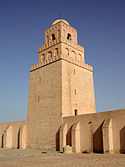Qadi Abd al-Wahhab
'Abd al-Wahhab ibn Ali ibn Nasr at-Taghlibi al-Baghdadi al-Maliki | |
|---|---|
| Title | Qadi 'Abd al-Wahhab |
| Personal | |
| Born | 973 CE (362 AH) Baghdad, Iraq |
| Died | 1031 CE (422 AH) Cairo, Egypt |
| Religion | Islam |
| Era | Later Abbasid era |
| Region | Iraq and Egypt |
| Jurisprudence | Maliki |
| Main interest(s) | Fiqh |
| Notable work(s) | at-Talqin (The Tuition) |
Qadi 'Abd al-Wahhab ibn Ali ibn Naṣr ibn Ahmad ibn Hussein ibn Harun ibn Malik ibn Tawk al-Taghlibi (Arabic: القاضي عبدالوهّاب) (973 – 1035CE) (362 AH – 422 AH ), also known as Qadi Abdul Wahhab and Qadi 'Abd al-Wahhab al-Maliki was an important Iraqi jurist in the Maliki school. He was a seminal figure of the now extinct Iraqi School of the Maliki madhab. Qadi 'Abd al-Wahhab is also remembered for his knowledge of Arabic literature and poetry. He is known by the title Qadi meaning judge in Arabic, as he was a prominent judge in Abbasid Siirt and Badra.[1] He is best known for his work at-Talqin on Maliki fiqh which is still studied today, particularly for its recording of the positions of the Iraqi school of the Maliki madhab.
Life
[edit]'Abd al-Wahhab was born in Baghdad in 973 CE (362 AH) when Abbasid control was largely confined to a titular and spiritual role under al-Muti. The Shiite Buyid Dynasty largely dominated the political and military arena. Despite this, he studied under some of the most prominent Sunni Maliki scholars of Baghdad, most notably the Iraqi jurists Al-Abhari and Ibn al-Jallab as well as the Ash'ari theologian al-Baqillani. During the latter part of his life, he lived in poverty in Baghdad, and eventually left his hometown. It is recorded that on the day of his departure, he was followed by a group of notable civil servants to escort him to whom he reportedly responded:
Had I found among you a roll of bread every morning and every evening, I should not have turned from your town, as I would then have obtained all I wished for.
— Ibn Khallikan, Ibn Khallikan's Biographical Dictionary
Qadi 'Abd al-Wahhab moved to the Levant firstly, and then to Egypt where he settled. His fortunes changed in Egypt where he was highly regarded as a scholar. He died in 1031, allegedly of food poisoning. He was buried in the Qarafa cemetery in Cairo between the tomb of Imam al-Shafi and the gates of Qarafa. His tomb is near that of Ibn al-Qasim and Ashhab, two notable direct students of Imam Malik.[2]

